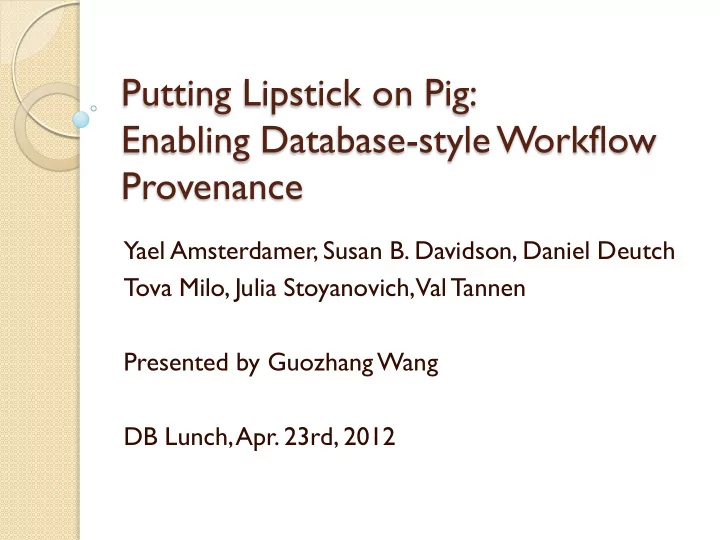

Putting Lipstick on Pig: Enabling Database-style Workflow Provenance Yael Amsterdamer, Susan B. Davidson, Daniel Deutch Tova Milo, Julia Stoyanovich, Val Tannen Presented by GuozhangWang DB Lunch, Apr. 23rd, 2012
A Story of “How Research Ideas Get Motivated” A short time ago, somewhere in the Globe of CS Research …
Workflow Provenance Motivated by Scientific Workflows ◦ Community : IPAW ◦ Interests: process documentation, data derivation and annotation, etc ◦ Model : OPM
OPM Model Annotated directed acyclic graph ◦ Artifact: immutable piece of state ◦ Process: actions performed on artifacts, result in new artifacts ◦ Agents: execute and control processes Aims to capture causal dependencies between agents/processes Each process is treated as a “black - box”
Meanwhile On the other side of the Globe …
Data Provenance (for Relational DB and XML) Motivated by Prob. DB, data warehousing .. ◦ Community: SIGMOD/PODS ◦ Interests: data auditing, data sharing, etc ◦ Model: Semiring (etc)
Semiring K-relations ◦ Each tuple is uniquely labeled with a provenance “token” Operations: ◦ • : join ◦ + : projection ◦ 0 and 1: selection predicates
A Datalog Example of Semiring q(x,z) :- R(x, _,z), R(_, _,z) q(x,z) :- R(x,y, _), R(_ ,y,z) q(R) R a b c p a c 2p 2 d b e r a e pr f g e s d c pr 2r 2 + rs d e 2s 2 + rs f e Slide borrowed from Green et al.
They Live Happily and Semi- Separately, Until … Workflow Provenance Researchers Data Provenance Researchers
Semiring Comes to Meet OPM
OPM’s Drawbacks in Semiring People’s Eyes The black-box assumption: each output of the module depends solely on all its inputs ◦ Cannot leverage the common fact that some output only depends on small subset of inputs ◦ Does not capture internal state of a module So: replace it with Semirings!
The Idea General workflow modules is complicated, and thus hard to capture its internal logic by annotations However, modules written in Pig Latin is very similar to Nested Relational Calculus (NRC), thus are much more feasible Let us write a paper, woho!
End-of-Story Disclaimer This story is purely imaginative. It is to be coincidental if there are similarities between the story and the real world.
Pig Latin Data: unordered (nested) bag of tuples Operators: ◦ FOREACH t GENERATE f1, f2, … OP(f0) ◦ FILTER BY condition ◦ GROUP/COGROUP ◦ UNION, JOIN, FLATTEN, DISTINCT …
Example: Car Dealership
Bid Request Handling in Pig Latin Inventory: { CarId, Model } ReqModel: { Model } CarsByModel: { Model, { CarId } } NumSoldByModel: { Model, NumSold} SoldInventory: { CarId, Model, BidId } NumCarsByModel: { Model, NumAvail} AllInfoByModel: { UserId, BidId, Model, NumA, NumS } SoldByModel: { Model, { CarId, BidId } }
Provenance Annotation
Provenance Annotation 1.1 Provenance node and value nodes ◦ Workflow input nodes ◦ Module invocation nodes ◦ Module input/output nodes
Provenance Annotation I.2 State nodes ◦ P-node for the tuple ◦ P-node for the state
Provenance Annotation 2.1 FOREACH (projection, no OP) ◦ P- node with “+”
Provenance Annotation 2.2 JOIN ◦ P- node with “*”
Provenance Annotation 2.3 GROUP ◦ P- node with “∂”
Provenance Annotation 2.4 FOREACH (aggregation, OP) ◦ V-node with the OP name
Provenance Annotation 2.5 COGROUP ◦ P- node with “∂”
Provenance Annotation 2.6 FOREACH (UDF Black Box) ◦ P-node/V-node with the UDF name
Query Provenance Graph Zoom-In v.s. Zoom-Out Coarse-grained Fine-grained
Query Provenance Graph Deletion Propagation ◦ Delete the tuple P-node and its out-edges ◦ Repeated delete P-nodes if All its in-edges are deleted It has label • and one of its in -edges is deleted
Implementation and Experiments Lipstick prototype ◦ Provenance annotation coded in Pig Latin, with the graph written to files ◦ Query processing coded in Java and runs in memory. Benchmark data ◦ Car dealership: fixed workflow and # dealers ◦ Arctic Station: Varied workflow structure and size
Annotation Overhead Overhead increases with execution time
Annotation Overhead Parallelism helps with up to # modules
Loading Graph Overhead Increase with graph size (comp. time < 4 sec)
Loading Graph Overhead Feasible with various sizes (comp. time ~ 8 sec)
Subgraph Query Time Query efficiently with sub-second time
Conclusions Thank hank You! ou! Data provenance ideas such as Semirings can be brought to workflow provenance for those “relational” programs No second conclusion, sorry ..
Backup Slides
The introduction of MapReduce/Dryad/Hadoop … ◦ Originally designed for data-driven web applications ◦ Helped gaining DB researchers attentions back to workflow apps
Recommend
More recommend